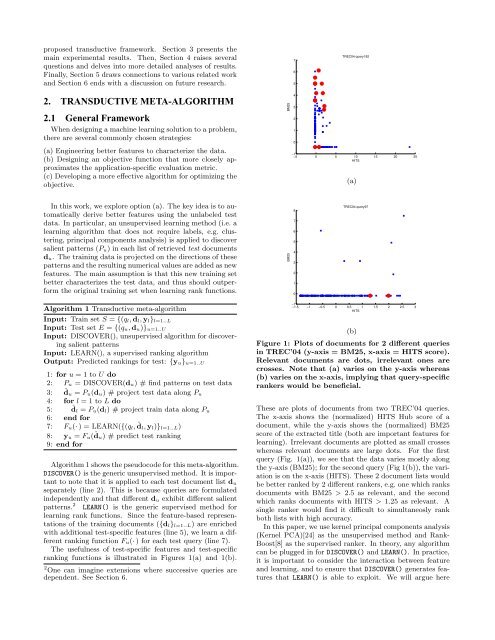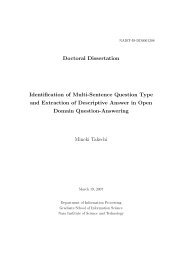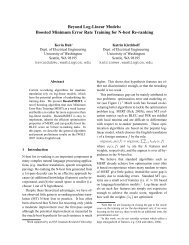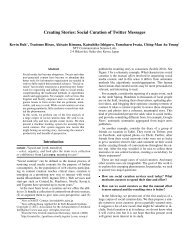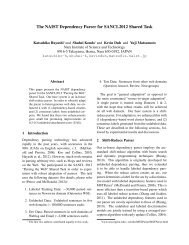Learning to Rank with Partially-Labeled Data - University of ...
Learning to Rank with Partially-Labeled Data - University of ...
Learning to Rank with Partially-Labeled Data - University of ...
You also want an ePaper? Increase the reach of your titles
YUMPU automatically turns print PDFs into web optimized ePapers that Google loves.
proposed transductive framework. Section 3 presents the<br />
main experimental results. Then, Section 4 raises several<br />
questions and delves in<strong>to</strong> more detailed analyses <strong>of</strong> results.<br />
Finally, Section 5 draws connections <strong>to</strong> various related work<br />
and Section 6 ends <strong>with</strong> a discussion on future research.<br />
7<br />
6<br />
5<br />
TREC04 query192<br />
2. TRANSDUCTIVE META-ALGORITHM<br />
2.1 General Framework<br />
When designing a machine learning solution <strong>to</strong> a problem,<br />
there are several commonly chosen strategies:<br />
(a) Engineering better features <strong>to</strong> characterize the data.<br />
(b) Designing an objective function that more closely approximates<br />
the application-specific evaluation metric.<br />
(c) Developing a more effective algorithm for optimizing the<br />
objective.<br />
BM25<br />
4<br />
3<br />
2<br />
1<br />
0<br />
−1<br />
−5 0 5 10 15 20 25<br />
HITS<br />
(a)<br />
In this work, we explore option (a). The key idea is <strong>to</strong> au<strong>to</strong>matically<br />
derive better features using the unlabeled test<br />
data. In particular, an unsupervised learning method (i.e. a<br />
learning algorithm that does not require labels, e.g. clustering,<br />
principal components analysis) is applied <strong>to</strong> discover<br />
salient patterns (P u) in each list <strong>of</strong> retrieved test documents<br />
d u. The training data is projected on the directions <strong>of</strong> these<br />
patterns and the resulting numerical values are added as new<br />
features. The main assumption is that this new training set<br />
better characterizes the test data, and thus should outperform<br />
the original training set when learning rank functions.<br />
BM25<br />
8<br />
7<br />
6<br />
5<br />
4<br />
3<br />
2<br />
1<br />
0<br />
TREC04 query97<br />
Algorithm 1 Transductive meta-algorithm<br />
Input: Train set S = {(q l , d l , y l } l=1..L<br />
Input: Test set E = {(q u, d u)} u=1..U<br />
Input: DISCOVER(), unsupervised algorithm for discovering<br />
salient patterns<br />
Input: LEARN(), a supervised ranking algorithm<br />
Output: Predicted rankings for test: {y u} u=1..U<br />
1: for u = 1 <strong>to</strong> U do<br />
2: P u = DISCOVER(d u) # find patterns on test data<br />
3: ˆdu = P u(d u) # project test data along P u<br />
4: for l = 1 <strong>to</strong> L do<br />
5: ˆdl = P u(d l ) # project train data along P u<br />
6: end for<br />
7: F u(· ) = LEARN({(q l , ˆd l , y l )} l=1..L )<br />
8: y u = F u(ˆd u) # predict test ranking<br />
9: end for<br />
Algorithm 1 shows the pseudocode for this meta-algorithm.<br />
DISCOVER() is the generic unsupervised method. It is important<br />
<strong>to</strong> note that it is applied <strong>to</strong> each test document list d u<br />
separately (line 2). This is because queries are formulated<br />
independently and that different d u exhibit different salient<br />
patterns. 2 LEARN() is the generic supervised method for<br />
learning rank functions. Since the feature-based representations<br />
<strong>of</strong> the training documents ({d l } l=1..L ) are enriched<br />
<strong>with</strong> additional test-specific features (line 5), we learn a different<br />
ranking function F u(· ) for each test query (line 7).<br />
The usefulness <strong>of</strong> test-specific features and test-specific<br />
ranking functions is illustrated in Figures 1(a) and 1(b).<br />
2 One can imagine extensions where successive queries are<br />
dependent. See Section 6.<br />
−1<br />
−1.5 −1 −0.5 0 0.5 1 1.5 2 2.5 3<br />
HITS<br />
(b)<br />
Figure 1: Plots <strong>of</strong> documents for 2 different queries<br />
in TREC’04 (y-axis = BM25, x-axis = HITS score).<br />
Relevant documents are dots, irrelevant ones are<br />
crosses. Note that (a) varies on the y-axis whereas<br />
(b) varies on the x-axis, implying that query-specific<br />
rankers would be beneficial.<br />
These are plots <strong>of</strong> documents from two TREC’04 queries.<br />
The x-axis shows the (normalized) HITS Hub score <strong>of</strong> a<br />
document, while the y-axis shows the (normalized) BM25<br />
score <strong>of</strong> the extracted title (both are important features for<br />
learning). Irrelevant documents are plotted as small crosses<br />
whereas relevant documents are large dots. For the first<br />
query (Fig. 1(a)), we see that the data varies mostly along<br />
the y-axis (BM25); for the second query (Fig 1(b)), the variation<br />
is on the x-axis (HITS). These 2 document lists would<br />
be better ranked by 2 different rankers, e.g. one which ranks<br />
documents <strong>with</strong> BM25 > 2.5 as relevant, and the second<br />
which ranks documents <strong>with</strong> HITS > 1.25 as relevant. A<br />
single ranker would find it difficult <strong>to</strong> simultaneosly rank<br />
both lists <strong>with</strong> high accuracy.<br />
In this paper, we use kernel principal components analysis<br />
(Kernel PCA)[24] as the unsupervised method and <strong>Rank</strong>-<br />
Boost[8] as the supervised ranker. In theory, any algorithm<br />
can be plugged in for DISCOVER() and LEARN(). In practice,<br />
it is important <strong>to</strong> consider the interaction between feature<br />
and learning, and <strong>to</strong> ensure that DISCOVER() generates features<br />
that LEARN() is able <strong>to</strong> exploit. We will argue here


